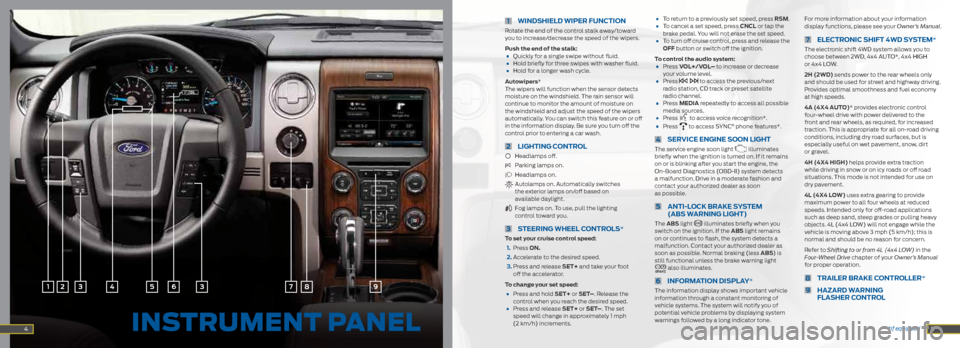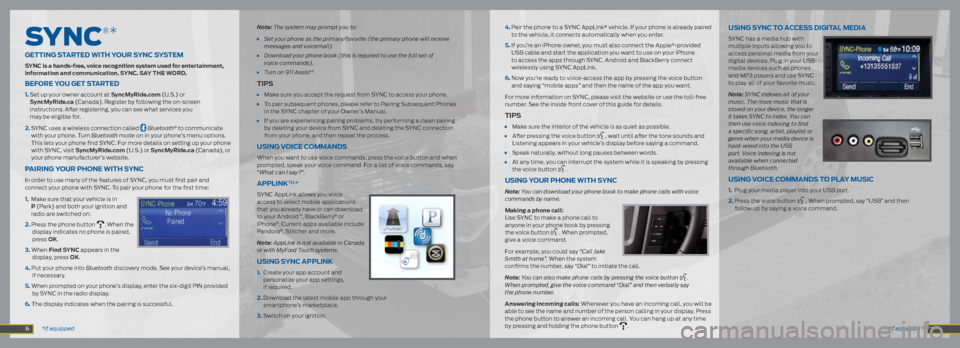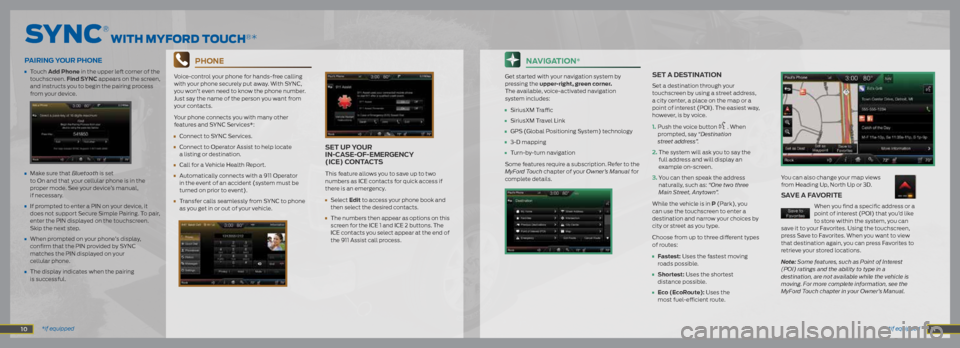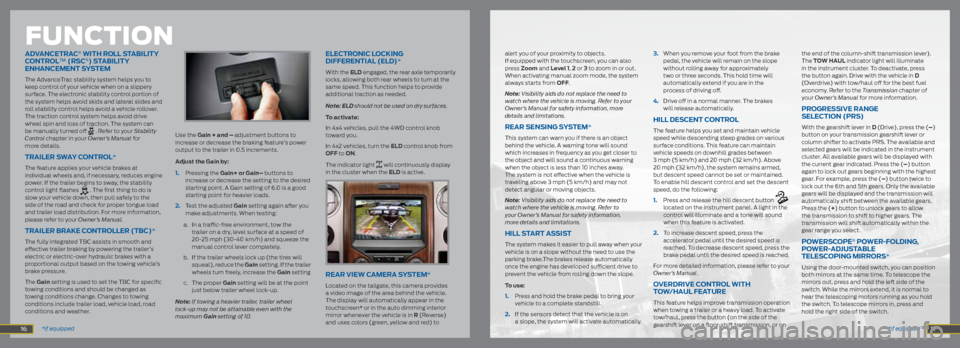display FORD F150 2014 12.G Quick Reference Guide
[x] Cancel search | Manufacturer: FORD, Model Year: 2014, Model line: F150, Model: FORD F150 2014 12.GPages: 10, PDF Size: 9 MB
Page 3 of 10

1
Wind Shield Wiper FUnC tion
Rotate the end of the control stalk away/toward
you to increase/decrease the speed of the wipers.
push the end of the stalk:
• Quickly for a single swipe without fluid.• Hold briefly for three swipes with washer fluid.• Hold for a longer wash cycle.
a utowipers*
The wipers will function when the sensor detects
moisture on the windshield. The rain sensor will
continue to monitor the amount of moisture on
the windshield and adjust the speed of the wipers
automatically. You can switch this feature on or off
in the information display. Be sure you turn off the
control prior to entering a car wash.
2
lighting Control
Headlamps off.
Parking lamps on.
Headlamps on.
Autolamps on. Automatically switches
the exterior lamps on/off based on
available daylight.
Fog lamps on. To use, pull the lighting
control toward you.
3
Steering Wheel C ontrolS*
to set your cruise control speed:
1. Press on.
2. Accelerate to the desired speed.
3. Press and release Set+ and take your foot
off the accelerator.
t o change your set speed:
• Press and hold Set+ or Set –. Release the
control when you reach the desired speed.
• Press and release Set+ or Set –. The set
speed will change in approximately 1 mph
(2 km/h) increments.
• To return to a previously set speed, press rS m.• To cancel a set speed, press CnCl or tap the
brake pedal. You will not erase the set speed.
• To turn off cruise control, press and release the
oFF button or switch off the ignition.
t o control the audio system:
• Press vol+/vol – to increase or decrease
your volume level.
• Press to access the previous/next
radio station, CD track or preset satellite
radio channel.
• Press media repeatedly to access all possible
media sources.
• Press to access voice recognition*.• Press to access SYNC® phone features*.
4
ServiCe engine S oon light
The service engine soon light illuminates
briefly when the ignition is turned on. If it remains
on or is blinking after you start the engine, the
On-Board Diagnostics (OBD-II) system detects
a malfunction. Drive in a moderate fashion and
contact your authorized dealer as soon
as possible.
5 anti-loCK BraKe SYS
tem
( aBS W arning light)
The aBS light illuminates briefly when you
switch on the ignition. If the aBS light remains
on or continues to flash, the system detects a
malfunction. Contact your authorized dealer as
soon as possible. Normal braking (less aBS) is
still functional unless the brake warning light
also illuminates.
6
inF ormation diSpla Y*
The information display shows important vehicle
information through a constant monitoring of
vehicle systems. The system will notify you of
potential vehicle problems by displaying system
warnings followed by a long indicator tone. For more information about your information
display functions, please see your Owner’s Manual.
7
ele
CtroniC ShiFt 4Wd SYS tem*
The electronic shift 4WD system allows you to
choose between 2WD, 4x4 AUTO*, 4x4 HIGH
or 4x4 LOW.
2h (2Wd) sends power to the rear wheels only
and should be used for street and highway driving.
Provides optimal smoothness and fuel economy
at high speeds.
4a (4x4 a Uto)* provides electronic control
four-wheel drive with power delivered to the
front and rear wheels, as required, for increased
traction. This is appropriate for all on-road driving
conditions, including dry road surfaces, but is
especially useful on wet pavement, snow, dirt
or gravel.
4h (4x4 high) helps provide extra traction
while driving in snow or on icy roads or off road
situations. This mode is not intended for use on
dry pavement.
4l (4x4 lo W) uses extra gearing to provide
maximum power to all four wheels at reduced
speeds. Intended only for off-road applications
such as deep sand, steep grades or pulling heavy
objects. 4L (4x4 LOW) will not engage while the
vehicle is moving above 3 mph (5 km/h); this is
normal and should be no reason for concern.
Refer to Shifting to or from 4L (4x4 LOW) in the
Four-Wheel Drive chapter of your Owner’s Manual
for proper operation.
8 trailer BraKe C
ontroller*
9 ha
Zard Warning
Fla Sher C ontrol
4 *if equipped
2133678945
INS
tRUmENt paNEL 5
Page 4 of 10

SyNC
®*
getting Started With Yo Ur SYnC SYStem
SYnC is a hands-free, voice recognition system used for entertainment,
information and communication. SYnC. S aY the W ord.
BeFore Yo U get Started
1. Set up your owner account at Syncmyride.com (U.S.) or
Syncmyride.ca (Canada). Register by following the on-screen
instructions. After registering, you can see what services you
may be eligible for.
2. SYNC uses a wireless connection called
Bluetooth® to communicate
with your phone. Turn Bluetooth mode on in your phone’s menu options.
This lets your phone find SYNC. For more details on setting up your phone
with SYNC, visit Syncmyride.com (U.S.) or Syncmyride.ca (Canada), or
your phone manufacturer’s website.
p airing Y oUr phone With SYnC
In order to use many of the features of SYNC, you must first pair and
connect your phone with SYNC. To pair your phone for the first time:
1. Make sure that your vehicle is in
p (Park) and both your ignition and
radio are switched on.
2. Press the phone button
. When the
display indicates no phone is paired,
press oK.
3. When Find SYnC appears in the display, press oK.
4. Put your phone into Bluetooth discovery mode. See your device’s manual, if necessary.
5. When prompted on your phone’s display, enter the six-digit PIN provided by SYNC in the radio display.
6. The display indicates when the pairing is successful. Note:
The system may prompt you to:
• Set your phone as the primary/favorite (the primary phone will receive
messages and voicemail).
• Download your phone book (this is required to use the full set of
voice commands).
• Turn on 911 Assist®.
tip S
• Make sure you accept the request from SYNC to access your phone.
• To pair subsequent phones, please refer to Pairing Subsequent Phones
in the SYNC chapter of your Owner’s Manual.
• If you are experiencing pairing problems, try performing a clean pairing
by deleting your device from SYNC and deleting the SYNC connection
from your phone, and then repeat the process.
USing voiCe C ommandS
When you want to use voice commands, press the voice button and when
prompted, speak your voice command. For a list of voice commands, say
“What can I say?”.
applinK™*
SYNC AppLink allows you voice
access to select mobile applications
that you already have or can download
to your Android
™, BlackBerry® or
iPhone®. Current apps available include
Pandora®, Stitcher and more.
Note: AppLink is not available in Canada
or with MyFord Touch systems.
U Sing SYnC applinK
1. Create your app account and
personalize your app settings,
if required.
2. Download the latest mobile app through your
smartphone’s marketplace.
3. Switch on your ignition.
*if equipped
*if equipped 4.
Pair the phone to a SYNC AppLink* vehicle. If your phone is already paired
to the vehicle, it connects automatically when you enter.
5. If you’re an iPhone owner, you must also connect the Apple
®-provided
USB cable and start the application you want to use on your iPhone
to access the apps through SYNC. Android and BlackBerry connect
wirelessly using SYNC AppLink.
6. Now you’re ready to voice-access the app by pressing the voice button
and saying “mobile apps” and then the name of the app you want.
For more information on SYNC, please visit the website or use the toll-free
number. See the inside front cover of this guide for details.
tip S
• Make sure the interior of the vehicle is as quiet as possible.
• After pressing the voice button , wait until after the tone sounds and
Listening appears in your vehicle’s display before saying a command.
• Speak naturally, without long pauses between words.
• At any time, you can interrupt the system while it is speaking by pressing
the voice button .
USing Yo Ur phone With SYnC
Note: You can download your phone book to make phone calls with voice
commands by name.
making a phone call:
Use SYNC to make a phone call to
anyone in your phone book by pressing
the voice button
. When prompted,
give a voice command.
For example, you could say “Call Jake
Smith at home”. When the system
confirms the number, say “Dial” to initiate the call.
Note: You can also make phone calls by pressing the voice button
.
When prompted, give the voice command “Dial” and then verbally say
the phone number.
answering incoming calls: Whenever you have an incoming call, you will be
able to see the name and number of the person calling in your display. Press
the phone button to answer an incoming call. You can hang up at any time
by pressing and holding the phone button
.
USing SYnC to a CCeSS digital media
SYNC has a media hub with
multiple inputs allowing you to
access personal media from your
digital devices. Plug in your USB
media devices such as phones
and MP3 players and use SYNC
to play all of your favorite music.
Note: SYNC indexes all of your
music. The more music that is
stored on your device, the longer
it takes SYNC to index. You can
then use voice indexing to find
a specific song, artist, playlist or
genre when your media device is
hard-wired into the USB
port. Voice indexing is not
available when connected
through Bluetooth.
U Sing voiCe C ommandS to plaY mUSiC
1. Plug your media player into your USB port.
2. Press the voice button
. When prompted, say “USB” and then
follow up by saying a voice command.
7 6
Page 6 of 10

phone
Voice-control your phone for hands-free calling
with your phone securely put away. With SYNC,
you won’t even need to know the phone number.
Just say the name of the person you want from
your contacts.
Your phone connects you with many other
features and SYNC Services*:
• Connect to SYNC Services.
•
Connect to Operator Assist to help locate
a listing or destination.
• Call for a Vehicle Health Report.
• Automatically connects with a 911 Operator
in the event of an accident (system must be
turned on prior to event).
• Transfer calls seamlessly from SYNC to phone
as you get in or out of your vehicle.
*if equipped
SyNC
® wIth myFoRD toUCh®*
10 *if equipped
navigation*
Get started with your navigation system by
pressing the upper-right, green corner.
The available, voice-activated navigation
system includes:
•
SiriusXM Traffic
• SiriusXM Travel Link
• GPS (Global Positioning System) technology
• 3-D mapping
• Turn-by-turn navigation
Some features require a subscription. Refer to the
MyFord Touch chapter of your Owner’s Manual for
complete details.
Set a de Stination
Set a destination through your
touchscreen by using a street address,
a city center, a place on the map or a
point of interest (POI). The easiest way,
however, is by voice.
1. Push the voice button
. When
prompted, say “Destination
street address”.
2. The system will ask you to say the
full address and will display an
example on-screen.
3. You can then speak the address
naturally, such as: “One two three
Main Street, Anytown”.
While the vehicle is in p (Park), you
can use the touchscreen to enter a
destination and narrow your choices by
city or street as you type.
Choose from up to three different types
of routes:
• Fastest: Uses the fastest moving
roads possible.
• Shortest: Uses the shortest
distance possible.
• eco (ecor oute): Uses the
most fuel-efficient route.
Set Up Y oUr
in-C aSe-oF-emergenCY
(iCe) C ontaCtS
This feature allows you to save up to two
numbers as ICE contacts for quick access if
there is an emergency.
• Select edit to access your phone book and
then select the desired contacts.
• The numbers then appear as options on this
screen for the ICE 1 and ICE 2 buttons. The
ICE contacts you select appear at the end of
the 911 Assist call process.
pairing Y oUr phone
• Touch add phone in the upper left corner of the
touchscreen. Find SYnC appears on the screen,
and instructs you to begin the pairing process
from your device.
• Make sure that Bluetooth is set
to On and that your cellular phone is in the
proper mode. See your device’s manual,
if necessary.
• If prompted to enter a PIN on your device, it
does not support Secure Simple Pairing. To pair,
enter the PIN displayed on the touchscreen.
Skip the next step.
• When prompted on your phone’s display,
confirm that the PIN provided by SYNC
matches the PIN displayed on your
cellular phone.
• The display indicates when the pairing
is successful. You can also change your map views
from Heading Up, North Up or 3D.
Save a Favorite
When you find a specific address or a
point of interest (POI) that you’d like
to store within the system, you can
save it to your Favorites. Using the touchscreen,
press Save to Favorites. When you want to view
that destination again, you can press Favorites to
retrieve your stored locations.
Note: Some features, such as Point of Interest
(POI) ratings and the ability to type in a
destination, are not available while the vehicle is
moving. For more complete information, see the
MyFord Touch chapter in your Owner’s Manual.
11
Page 9 of 10

alert you of your proximity to objects.
If equipped with the touchscreen, you can also
press Zoom and level 1, 2 or 3 to zoom in or out.
When activating manual zoom mode, the system
always starts from oFF.
Note: Visibility aids do not replace the need to
watch where the vehicle is moving. Refer to your
Owner’s Manual for safety information, more
details and limitations.
rear SenSing S YStem*
This system can warn you if there is an object
behind the vehicle. A warning tone will sound
which increases in frequency as you get closer to
the object and will sound a continuous warning
when the object is less than 10 inches away.
The system is not effective when the vehicle is
traveling above 3 mph (5 km/h) and may not
detect angular or moving objects.
Note: Visibility aids do not replace the need to
watch where the vehicle is moving. Refer to
your Owner’s Manual for safety information,
more details and limitations.
hill S tart a SSiSt
The system makes it easier to pull away when your
vehicle is on a slope without the need to use the
parking brake.The brakes release automatically
once the engine has developed sufficient drive to
prevent the vehicle from rolling down the slope.
to use:
1. Press and hold the brake pedal to bring your
vehicle to a complete standstill.
2. If the sensors detect that the vehicle is on
a slope, the system will activate automatically. 3.
When you remove your foot from the brake
pedal, the vehicle will remain on the slope
without rolling away for approximately
two or three seconds. This hold time will
automatically extend if you are in the
process of driving off.
4. Drive off in a normal manner. The brakes
will release automatically.
hill de SCent C ontrol
The feature helps you set and maintain vehicle
speed while descending steep grades on various
surface conditions. This feature can maintain
vehicle speeds on downhill grades between
3 mph (5 km/h) and 20 mph (32 km/h). Above
20 mph (32 km/h), the system remains armed,
but descent speed cannot be set or maintained.
To enable hill descent control and set the descent
speed, do the following:
1. Press and release the hill descent button
located on the instrument panel. A light in the
control will illuminate and a tone will sound
when this feature is activated.
2. To increase descent speed, press the
accelerator pedal until the desired speed is
reached. To decrease descent speed, press the
brake pedal until the desired speed is reached.
For more detailed information, please refer to your
Owner’s Manual.
o verdrive C ontrol With
to W/ha Ul FeatUre
This feature helps improve transmission operation
when towing a trailer or a heavy load. To activate
tow/haul, press the button (on the side of the
gearshift lever on a floor-shift transmission, or on the end of the column-shift transmission lever).
The to
W haUl indicator light will illuminate
in the instrument cluster. To deactivate, press
the button again. Drive with the vehicle in d
(Overdrive) with tow/haul off for the best fuel
economy. Refer to the Transmission chapter of
your Owner’s Manual for more information.
progre SSive range
Sele Ction (pr S)
With the gearshift lever in d (Drive), press the (–)
button on your transmission gearshift lever or
column shifter to activate PRS. The available and
selected gears will be indicated in the instrument
cluster. All available gears will be displayed with
the current gear indicated. Press the (–) button
again to lock out gears beginning with the highest
gear. For example, press the (–) button twice to
lock out the 6th and 5th gears. Only the available
gears will be displayed and the transmission will
automatically shift between the available gears.
Press the (+) button to unlock gears to allow
the transmission to shift to higher gears. The
transmission will shift automatically within the
gear range you select.
poWer SCope® po Wer -Folding,
p o Wer-adjUS taBle
tele SCoping mirror S*
Using the door-mounted switch, you can position
both mirrors at the same time. To telescope the
mirrors out, press and hold the left side of the
switch. While the mirrors extend, it is normal to
hear the telescoping motors running as you hold
the switch. To telescope mirrors in, press and
hold the right side of the switch.
FUNCtIoN
advanCetra C® With roll StaBilitY
C ontrol™ ( rSC®) StaBilitY
enhanCement SYS tem
The AdvanceTrac stability system helps you to
keep control of your vehicle when on a slippery
surface. The electronic stability control portion of
the system helps avoid skids and lateral slides and
roll stability control helps avoid a vehicle rollover.
The traction control system helps avoid drive
wheel spin and loss of traction. The system can
be manually turned off
. Refer to your Stability
Control chapter in your Owner’s Manual for
more details.
trailer S WaY C ontrol*
The feature applies your vehicle brakes at
individual wheels and, if necessary, reduces engine
power. If the trailer begins to sway, the stability
control light flashes
. The first thing to do is
slow your vehicle down, then pull safely to the
side of the road and check for proper tongue load
and trailer load distribution. For more information,
please refer to your Owner’s Manual.
trailer BraKe C ontroller (tBC)*
The fully integrated TBC assists in smooth and
effective trailer braking by powering the trailer’s
electric or electric-over hydraulic brakes with a
proportional output based on the towing vehicle’s
brake pressure.
The gain setting is used to set the TBC for specific
towing conditions and should be changed as
towing conditions change. Changes to towing
conditions include trailer load, vehicle load, road
conditions and weather. Use the g
ain + and – adjustment buttons to
increase or decrease the braking feature’s power
output to the trailer in 0.5 increments.
a djust the g ain by:
1. Pressing the g ain+ or gain– buttons to
increase or decrease the setting to the desired
starting point. A Gain setting of 6.0 is a good
starting point for heavier loads.
2. Test the adjusted g ain setting again after you
make adjustments. When testing:
a. In a traffic-free environment, tow the
trailer on a dry, level surface at a speed of
20-25 mph (30-40 km/h) and squeeze the
manual control lever completely.
b. If the trailer wheels lock up (the tires will
squeal), reduce the g ain setting. If the trailer
wheels turn freely, increase the g ain setting
c. The proper g ain setting will be at the point
just below trailer wheel lock-up.
Note: If towing a heavier trailer, trailer wheel
lock-up may not be attainable even with the
maximum Gain setting of 10.
ele CtroniC loCKing
diFFerential (eld )*
With the eld engaged, the rear axle temporarily
locks, allowing both rear wheels to turn at the
same speed. This function helps to provide
additional traction as needed.
Note: ELD should not be used on dry surfaces.
to activate:
In 4x4 vehicles, pull the 4WD control knob
toward you.
In 4x2 vehicles, turn the eld control knob from
oFF to on.
The indicator light
will continuously display
in the cluster when the eld is active.
rear vieW Camera S YStem*
Located on the tailgate, this camera provides
a video image of the area behind the vehicle.
The display will automatically appear in the
touchscreen* or in the auto dimming interior
mirror whenever the vehicle is in r (Reverse)
and uses colors (green, yellow and red) to
*if equipped
*if equipped
16 17